Numerical Study of Multilayer Planar Film Structures for Ideal Absorption in the Entire Solar Spectrum
Abstract
Featured Application
Abstract
1. Introduction
2. Materials, Structure, and Methods
3. Results and Discussions
4. Conclusions
Author Contributions
Funding
Acknowledgments
Conflicts of Interest
References
- Atchuta, S.R.; Sakthivel, S.; Barshilia, H.C. Transition metal based CuxNiyCoz-x-yO4 spinel composite solar selective absorber coatings for concentrated solar thermal applications. Sol. Energ Mater. Sol. Cells 2019, 189, 226–232. [Google Scholar] [CrossRef]
- Chen, J.; Feng, J.; Li, Z.; Xu, P.; Wang, X.; Yin, W.; Wang, M.; Ge, X.; Yin, Y. Space-Confined Seeded Growth of Black Silver Nanostructures for Solar Steam Generation. Nano Lett. 2018, 19, 400–407. [Google Scholar] [CrossRef]
- Van Embden, J.; Della Gaspera, E. Ultrathin Solar Absorber Layers of Silver Bismuth Sulfide from Molecular Precursors. ACS Appl. Mater. Interfaces 2019, 11, 16674–16682. [Google Scholar] [CrossRef]
- Rephaeli, E.; Fan, S. Tungsten black absorber for solar light with wide angular operation range. Appl. Phys. Lett. 2008, 92, 211107. [Google Scholar] [CrossRef]
- Chen, C.L.; Zhou, L.; Yu, J.Y.; Wang, Y.X.; Nie, S.M. Dual functional asymmetric plasmonic structures for solar water purification and pollution detection. Nano Energy 2018, 51, 451–456. [Google Scholar] [CrossRef]
- Lin, L.; Peng, X.; Wang, M.; Scarabelli, L.; Mao, Z.; Liz-Marzán, L.M.; Becker, M.F.; Zheng, Y. Light-Directed Reversible Assembly of Plasmonic Nanoparticles Using Plasmon-Enhanced Thermophoresis. ACS Nano 2016, 10, 9659–9668. [Google Scholar] [CrossRef]
- Tan, F.; Wang, N.; Lei, D.Y.; Yu, W.; Zhang, X. Plasmonic Black Absorbers for Enhanced Photocurrent of Visible-Light Photocatalysis. Adv. Opt. Mater. 2017, 5, 1600399. [Google Scholar] [CrossRef]
- Ryu, Y.; Kim, C.; Ahn, J.; Urbas, A.M.; Park, W.; Kim, K. Material-Versatile Ultrabroadband Light Absorber with Self-Aggregated Multiscale Funnel Structures. ACS Appl. Mater. Interfaces 2018, 10, 29884–29892. [Google Scholar] [CrossRef]
- Lin, H.; Sturmberg, B.C.P.; Lin, K.; Yang, Y.; Zheng, X.; Chong, T.K.; de Sterke, C.M.; Jia, B. A 90-nm-thick graphene metamaterial for strong and extremely broadband absorption of unpolarized light. Nat. Photonics 2019, 13, 270–276. [Google Scholar] [CrossRef]
- Cong, J.; Zhou, Z.; Yun, B.; Lv, L.; Yao, H.; Fu, Y.; Ren, N. Broadband visible-light absorber via hybridization of propagating surface plasmon. Opt. Lett. 2016, 41, 1965–1968. [Google Scholar] [CrossRef]
- Aydin, K.; Ferry, V.E.; Briggs, R.M.; Atwater, H.A. Broadband polarization-independent resonant light absorption using ultrathin plasmonic super absorbers. Nat. Commun. 2011, 2, 1–7. [Google Scholar] [CrossRef]
- Tang, B.; Zhu, Y.; Zhou, X.; Huang, L.; Lang, X. Wide-Angle Polarization-Independent Broadband Absorbers Based on Concentric Multisplit Ring Arrays. IEEE Photonics J. 2017, 9, 1–7. [Google Scholar] [CrossRef]
- Li, Z.; Palacios, E.; Butun, S.; Kocer, H.; Aydin, K. Omnidirectional, broadband light absorption using large-area, ultrathin lossy metallic film coatings. Sci. Rep. 2015, 5, 15137. [Google Scholar] [CrossRef]
- Wan, C.; Ho, Y.; Nunez-Sanchez, S.; Chen, L.; Lopez-Garcia, M.; Pugh, J.; Zhu, B.; Cryan, M.J. A selective metasurface absorber with an amorphous carbon interlayer for solar thermal applications. Nano Energy 2016, 26, 392–397. [Google Scholar] [CrossRef]
- Wu, D.; Liu, Y.; Xu, Z.; Yu, Z.; Yu, L.; Chen, L.; Liu, C.; Li, R.; Ma, R.; Zhang, J.; et al. Numerical Study of the Wide-angle Polarization-Independent Ultra-Broadband Efficient Selective Solar Absorber in the Entire Solar Spectrum. Sol. RRL 2017, 1, 1700049. [Google Scholar] [CrossRef]
- Zhao, J.; Yu, X.; Yang, X.; Xiang, Q.; Duan, H.; Yu, Y. Polarization independent subtractive color printing based on ultrathin hexagonal nanodisk-nanohole hybrid structure arrays. Opt. Express 2017, 25, 23137–23145. [Google Scholar] [CrossRef]
- Chen, J.; Jin, Y.; Chen, P.; Shan, Y.; Xu, J.; Kong, F.; Shao, J. Polarization-independent almost-perfect absorber controlled from narrowband to broadband. Opt. Express 2017, 25, 13916–13922. [Google Scholar] [CrossRef]
- Moghimi, M.J.; Lin, G.; Jiang, H. Broadband and Ultrathin Infrared Stealth Sheets. Adv. Eng. Mater. 2018, 20, 1800038. [Google Scholar] [CrossRef]
- Wu, D.; Liu, C.; Liu, Y.; Yu, L.; Yu, Z.; Chen, L.; Ma, R.; Ye, H. Numerical study of an ultra-broadband near-perfect solar absorber in the visible and near-infrared region. Opt. Lett. 2017, 42, 450–453. [Google Scholar] [CrossRef]
- Yang, C.; Ji, C.; Shen, W.; Lee, K.; Zhang, Y.; Liu, X.; Guo, L.J. Compact Multilayer Film Structures for Ultrabroadband, Omnidirectional, and Efficient Absorption. ACS Photonics 2016, 3, 590–596. [Google Scholar] [CrossRef]
- Hu, E.; Liu, X.; Yao, Y.; Zang, K.; Tu, Z.; Jiang, A.; Yu, K.; Zheng, J.; Wei, W.; Zheng, Y.; et al. Multilayered metal-dielectric film structure for highly efficient solar selective absorption. Mater. Res. Express 2018, 5, 66428. [Google Scholar] [CrossRef]
- Deng, H.; Li, Z.; Stan, L.; Rosenmann, D.; Czaplewski, D.; Gao, J.; Yang, X. Broadband perfect absorber based on one ultrathin layer of refractory metal. Opt. Lett. 2015, 40, 2592–2595. [Google Scholar] [CrossRef]
- García, G.; Sánchez-Palencia, P.; Palacios, P.; Wahnón, P. Transition Metal-Hyperdoped InP Semiconductors as Efficient Solar Absorber Materials. Nanomaterials 2020, 10, 283. [Google Scholar] [CrossRef]
- Li, J.; Chen, Z.; Yang, H.; Yi, Z.; Chen, X.; Yao, W.; Duan, T.; Wu, P.; Li, G.; Yi, Y. Tunable Broadband Solar Energy Absorber Based on Monolayer Transition Metal Dichalcogenides Materials Using Au Nanocubes. Nanomaterials 2020, 10, 257. [Google Scholar] [CrossRef]
- Liu, J.; Chen, W.; Zheng, J.-C.; Chen, Y.-S.; Yang, C.-F. Wide-Angle Polarization-Independent Ultra-Broadband Absorber from Visible to Infrared. Nanomaterials 2020, 10, 27. [Google Scholar] [CrossRef]
- Liu, J.; Chen, W.; Ma, W.; Yu, G.; Zheng, J.; Chen, Y.; Yang, C. Ultra-Broadband Infrared Absorbers Using Iron Thin Layers. IEEE Access 2020, 8, 43407–43412. [Google Scholar] [CrossRef]
- Zhu, P.; Jay Guo, L. High performance broadband absorber in the visible band by engineered dispersion and geometry of a metal-dielectric-metal stack. Appl. Phys. Lett. 2012, 101, 241116. [Google Scholar] [CrossRef]
- Lei, L.; Li, S.; Huang, H.; Tao, K.; Xu, P. Ultra-broadband absorber from visible to near-infrared using plasmonic metamaterial. Opt. Express 2018, 26, 5686–5693. [Google Scholar] [CrossRef]
- Chen, H.-P.; Lee, C.-T.; Liao, W.-B.; Chang, Y.-C.; Chen, Y.-S.; Li, M.-C.; Lee, C.-C.; Kuo, C.-C. Analysis of High-Efficiency Mo-Based Solar Selective Absorber by Admittance Locus Method. Coatings 2019, 9, 256. [Google Scholar] [CrossRef]
- Pang, X.; Wei, Q.; Zhou, J.; Ma, H. High-Temperature Tolerance in Multi-Scale Cermet Solar-Selective Absorbing Coatings Prepared by Laser Cladding. Materials 2018, 11, 1037. [Google Scholar] [CrossRef]
- Zou, Y.; Cao, J.; Gong, X.; Qian, R.; An, Z. Ultrathin and Electrically Tunable Metamaterial with Nearly Perfect Absorption in Mid-Infrared. Appl. Sci. 2019, 9, 3358. [Google Scholar] [CrossRef]
- Rance, O.; Lepage, A.C.; Begaud, X.; Elis, K.; Capet, N. Oblique Wide-Angle Multi-Sector Metamaterial Absorber for Space Applications. Appl. Sci. 2019, 9, 3425. [Google Scholar] [CrossRef]
- Wang, J.; Lang, T.; Shen, T.; Shen, C.; Hong, Z.; Lu, C. Numerical Study of an Ultra-Broadband All-Silicon Terahertz Absorber. Appl. Sci. 2020, 10, 436. [Google Scholar] [CrossRef]
- Jiang, X.; Zhang, Z.; Wen, K.; Li, G.; He, J.; Yang, J. A Triple-Band Hybridization Coherent Perfect Absorber Based on Graphene Metamaterial. Appl. Sci. 2020, 10, 1750. [Google Scholar] [CrossRef]
- Shang, A.; Li, X. Photovoltaic Devices: Opto-Electro-Thermal Physics and Modeling. Adv. Mater. 2017, 29, 1603492. [Google Scholar] [CrossRef] [PubMed]
- Zhang, C.; Wu, K.; Giannini, V.; Li, X. Planar Hot-Electron Photodetection with Tamm Plasmons. ACS Nano 2017, 11, 1719–1727. [Google Scholar] [CrossRef] [PubMed]
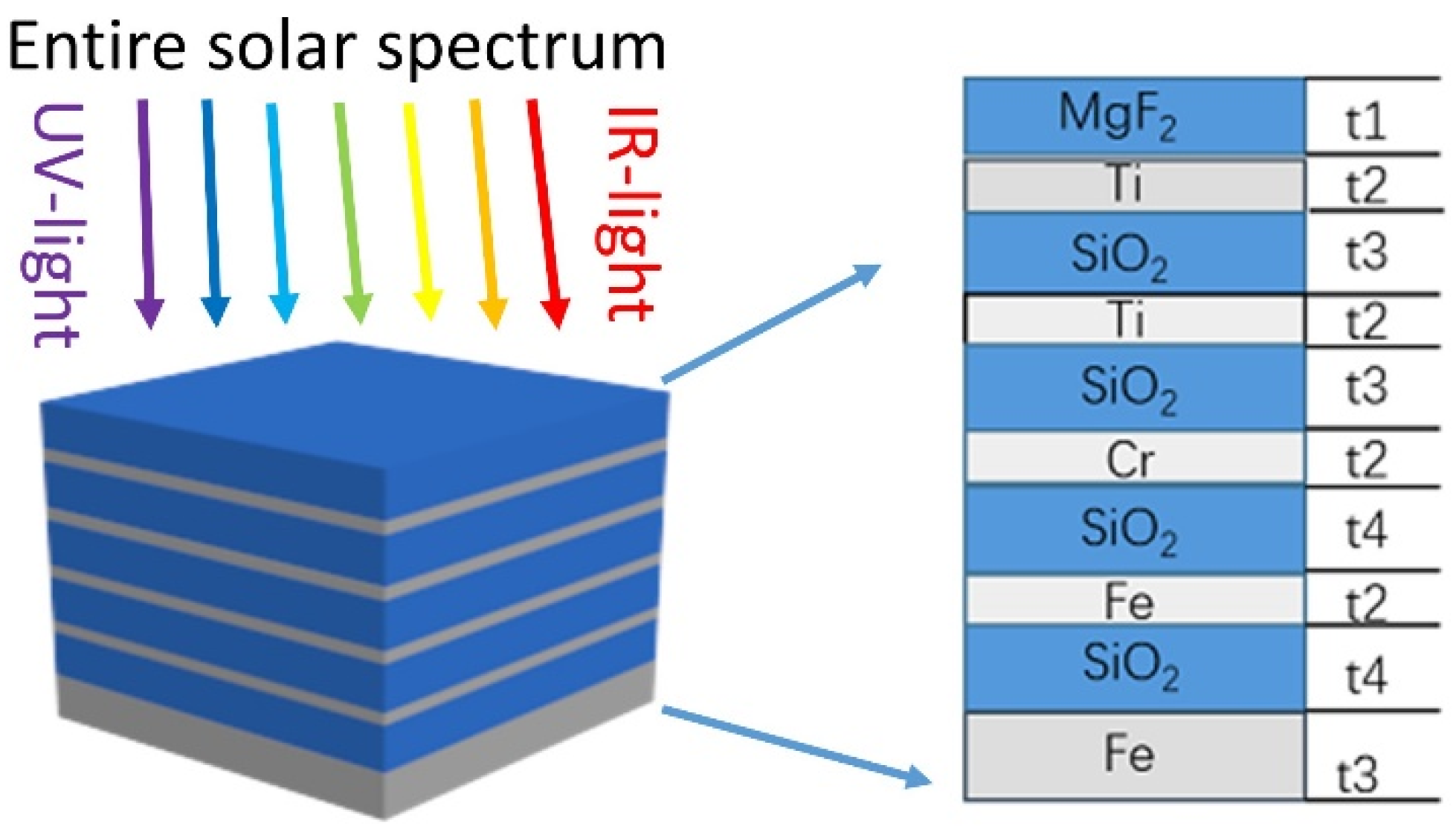
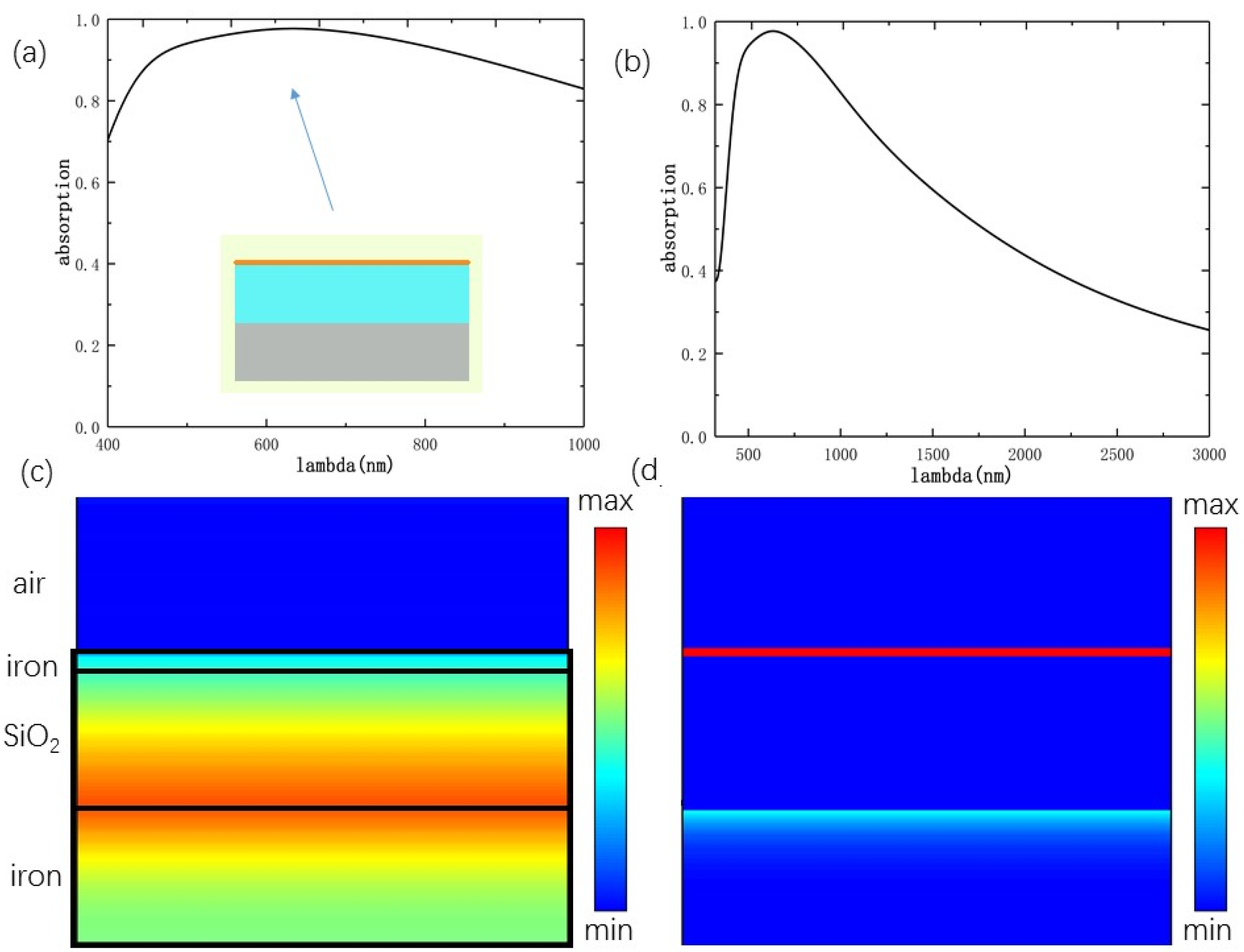
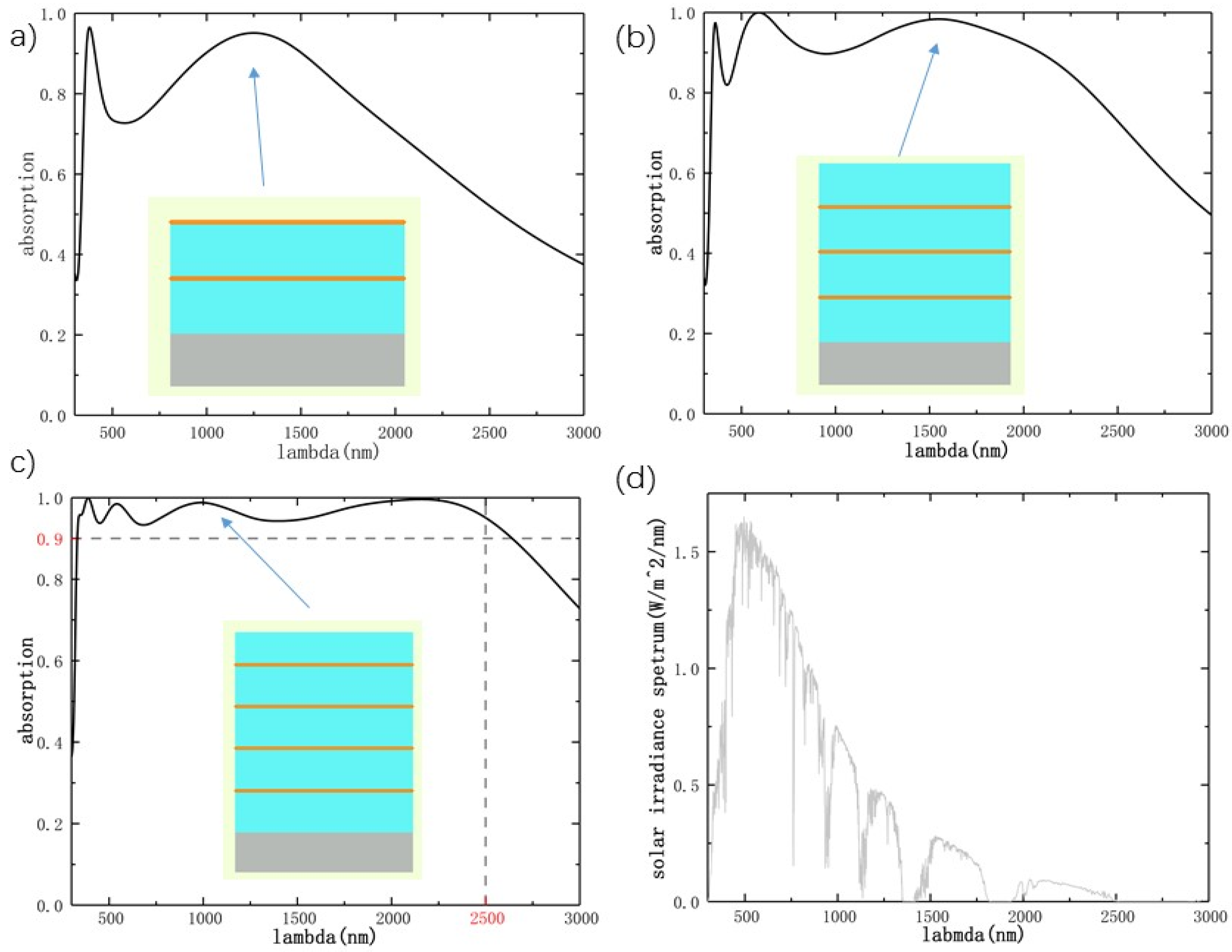

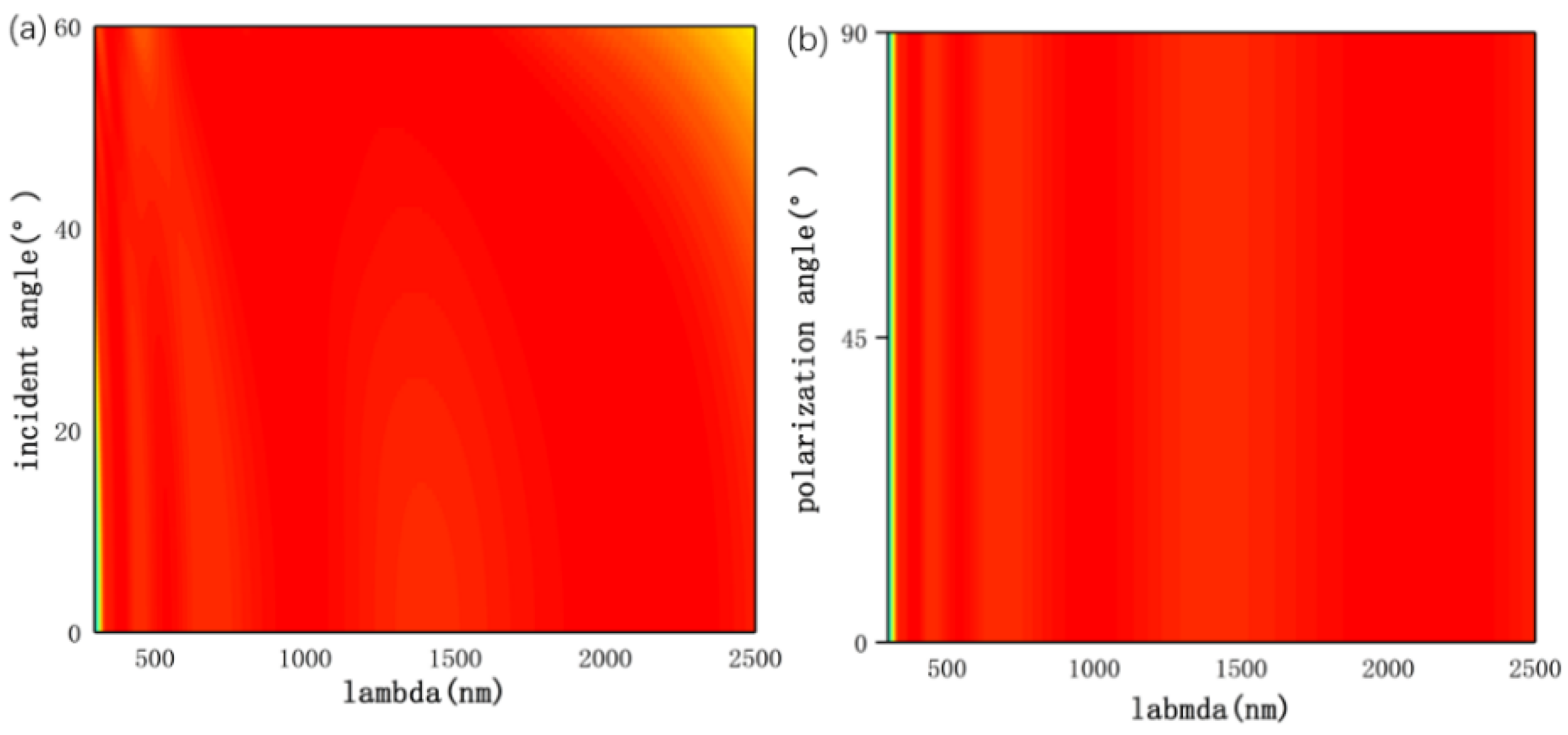
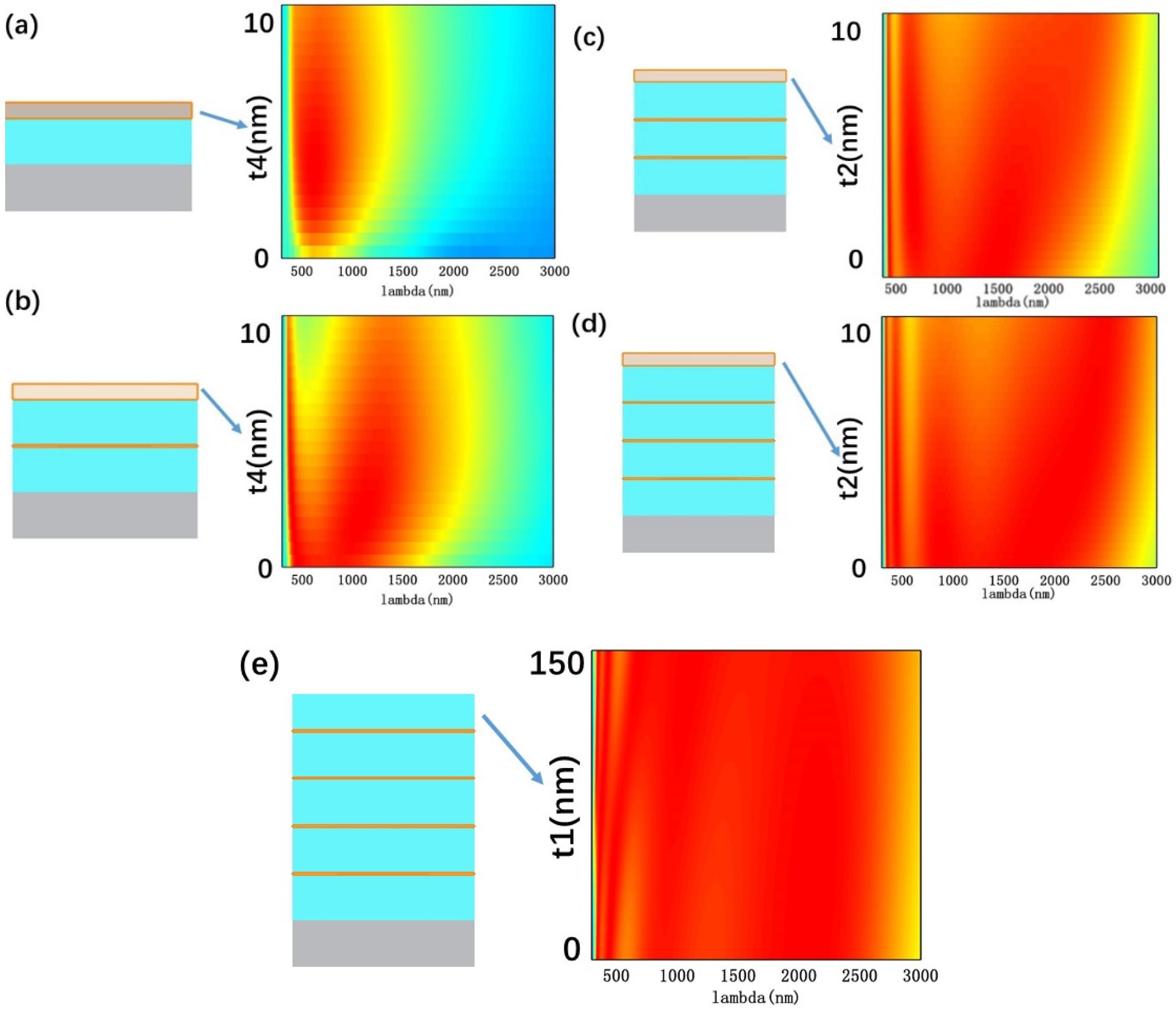
| Material | Ag | Au | Fe | Ti | Cr |
|---|---|---|---|---|---|
| Melting point (K) | 1234 | 1337 | 1811 | 1941 | 2180 |
| Reference | Bandwidth (nm) | Structure | Polarization Independent | Materials | Average Absorption |
|---|---|---|---|---|---|
| [19] | 400~2000 | Patterned structure | NO | non-noble material | ~96.4% |
| [13] | 400~800 | Planar film structure | YES | non-noble material | ~99.5% |
| [9] | 300~2500 | Patterned structure | YES | graphene | ~85% |
| [15] | 400~1520 | Patterned structure | YES | noble material | ~99% |
| this work | 300~2500 | Planar film structure | YES | non-noble material | 96.6% |
© 2020 by the authors. Licensee MDPI, Basel, Switzerland. This article is an open access article distributed under the terms and conditions of the Creative Commons Attribution (CC BY) license (http://creativecommons.org/licenses/by/4.0/).
Share and Cite
Chen, W.; Liu, J.; Ma, W.-Z.; Yu, G.-X.; Chen, J.-Q.; Cai, H.-Y.; Yang, C.-F. Numerical Study of Multilayer Planar Film Structures for Ideal Absorption in the Entire Solar Spectrum. Appl. Sci. 2020, 10, 3276. https://doi.org/10.3390/app10093276
Chen W, Liu J, Ma W-Z, Yu G-X, Chen J-Q, Cai H-Y, Yang C-F. Numerical Study of Multilayer Planar Film Structures for Ideal Absorption in the Entire Solar Spectrum. Applied Sciences. 2020; 10(9):3276. https://doi.org/10.3390/app10093276
Chicago/Turabian StyleChen, Wei, Jing Liu, Wen-Zhuang Ma, Gao-Xiang Yu, Jing-Qian Chen, Hao-Yuan Cai, and Cheng-Fu Yang. 2020. "Numerical Study of Multilayer Planar Film Structures for Ideal Absorption in the Entire Solar Spectrum" Applied Sciences 10, no. 9: 3276. https://doi.org/10.3390/app10093276
APA StyleChen, W., Liu, J., Ma, W.-Z., Yu, G.-X., Chen, J.-Q., Cai, H.-Y., & Yang, C.-F. (2020). Numerical Study of Multilayer Planar Film Structures for Ideal Absorption in the Entire Solar Spectrum. Applied Sciences, 10(9), 3276. https://doi.org/10.3390/app10093276






